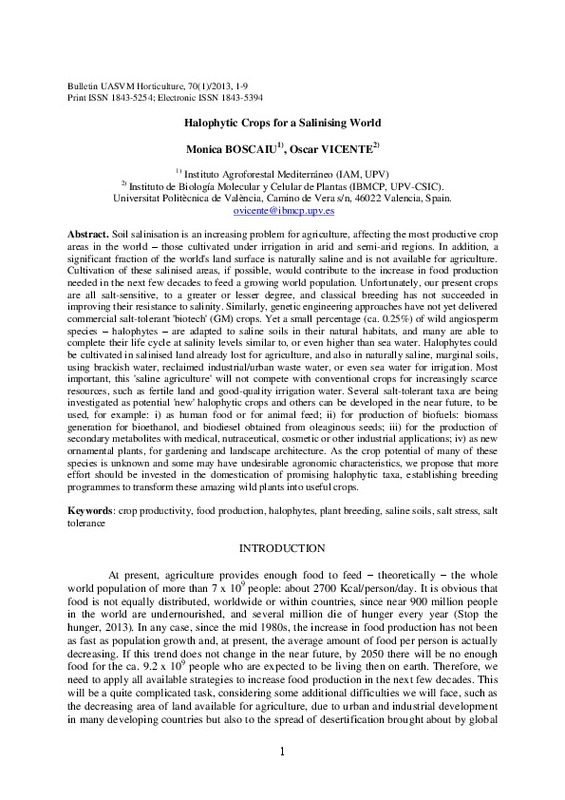JavaScript is disabled for your browser. Some features of this site may not work without it.
Buscar en RiuNet
Listar
Mi cuenta
Estadísticas
Ayuda RiuNet
Admin. UPV
Halophytic crops for a salinising world
Mostrar el registro sencillo del ítem
Ficheros en el ítem
| dc.contributor.author | Boscaiu Neagu, Mónica Tereza
|
es_ES |
| dc.contributor.author | Vicente Meana, Óscar
|
es_ES |
| dc.date.accessioned | 2016-09-08T06:41:31Z | |
| dc.date.available | 2016-09-08T06:41:31Z | |
| dc.date.issued | 2013 | |
| dc.identifier.issn | 1843-5254 | |
| dc.identifier.uri | http://hdl.handle.net/10251/69053 | |
| dc.description.abstract | Soil salinisation is an increasing problem for agriculture, affecting the most productive crop areas in the world those cultivated under irrigation in arid and semi-arid regions. In addition, a significant fraction of the world's land surface is naturally saline and is not available for agriculture. Cultivation of these salinised areas, if possible, would contribute to the increase in food production needed in the next few decades to feed a growing world population. Unfortunately, our present crops are all salt-sensitive, to a greater or lesser degree, and classical breeding has not succeeded in improving their resistance to salinity. Similarly, genetic engineering approaches have not yet delivered commercial salt-tolerant 'biotech' (GM) crops. Yet a small percentage (ca. 0.25%) of wild angiosperm species halophytes are adapted to saline soils in their natural habitats, and many are able to complete their life cycle at salinity levels similar to, or even higher than sea water. Halophytes could be cultivated in salinised land already lost for agriculture, and also in naturally saline, marginal soils, using brackish water, reclaimed industrial/urban waste water, or even sea water for irrigation. Most important, this 'saline agriculture' will not compete with conventional crops for increasingly scarce resources, such as fertile land and good-quality irrigation water. Several salt-tolerant taxa are being investigated as potential 'new' halophytic crops and others can be developed in the near future, to be used, for example: i) as human food or for animal feed; ii) for production of biofuels: biomass generation for bioethanol, and biodiesel obtained from oleaginous seeds; iii) for the production of secondary metabolites with medical, nutraceutical, cosmetic or other industrial applications; iv) as new ornamental plants, for gardening and landscape architecture. As the crop potential of many of these species is unknown and some may have undesirable agronomic characteristics, we propose that more effort should be invested in the domestication of promising halophytic taxa, establishing breeding programmes to transform these amazing wild plants into useful crops. | es_ES |
| dc.language | Inglés | es_ES |
| dc.publisher | University of Agricultural Sciences and Veterinary Medicine | es_ES |
| dc.relation.ispartof | Bulletin of University of Agricultural Sciences and Veterinary Medicine Cluj-Napoca : Horticulture | es_ES |
| dc.rights | Reconocimiento - No comercial - Sin obra derivada (by-nc-nd) | es_ES |
| dc.subject | Crop productivity | es_ES |
| dc.subject | Food production | es_ES |
| dc.subject | Halophytes | es_ES |
| dc.subject | Plant breeding | es_ES |
| dc.subject | Saline soils | es_ES |
| dc.subject | Salt stress | es_ES |
| dc.subject | Salt tolerance | es_ES |
| dc.subject.classification | BOTANICA | es_ES |
| dc.subject.classification | BIOQUIMICA Y BIOLOGIA MOLECULAR | es_ES |
| dc.title | Halophytic crops for a salinising world | es_ES |
| dc.type | Artículo | es_ES |
| dc.identifier.doi | 10.15835/buasvmcn-hort:9349 | |
| dc.rights.accessRights | Abierto | es_ES |
| dc.contributor.affiliation | Universitat Politècnica de València. Departamento de Ecosistemas Agroforestales - Departament d'Ecosistemes Agroforestals | es_ES |
| dc.contributor.affiliation | Universitat Politècnica de València. Departamento de Biotecnología - Departament de Biotecnologia | es_ES |
| dc.description.bibliographicCitation | Boscaiu Neagu, MT.; Vicente Meana, Ó. (2013). Halophytic crops for a salinising world. Bulletin of University of Agricultural Sciences and Veterinary Medicine Cluj-Napoca : Horticulture. 70(1):1-9. doi:10.15835/buasvmcn-hort:9349 | es_ES |
| dc.description.accrualMethod | S | es_ES |
| dc.relation.publisherversion | http://journals.usamvcluj.ro/index.php/horticulture/issue/view/243 | es_ES |
| dc.description.upvformatpinicio | 1 | es_ES |
| dc.description.upvformatpfin | 9 | es_ES |
| dc.type.version | info:eu-repo/semantics/publishedVersion | es_ES |
| dc.description.volume | 70 | es_ES |
| dc.description.issue | 1 | es_ES |
| dc.relation.senia | 253983 | es_ES |








